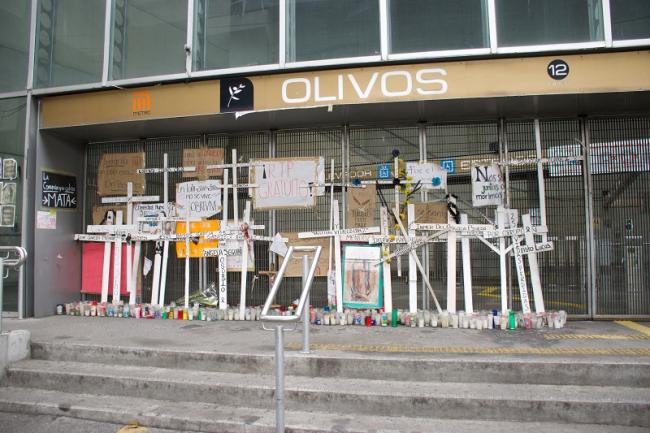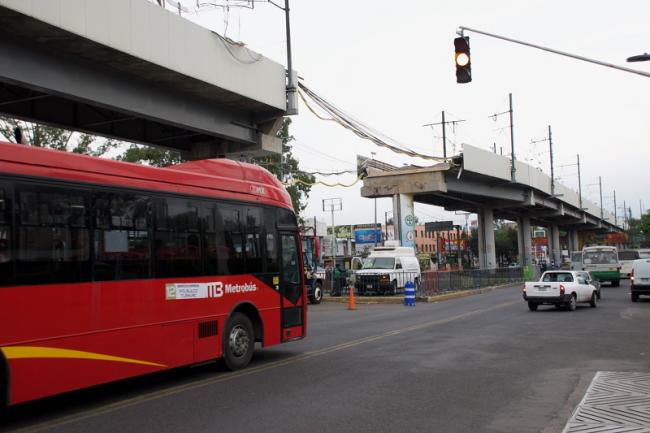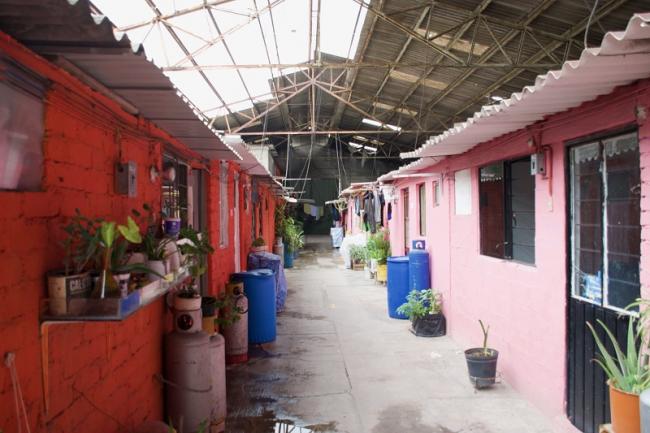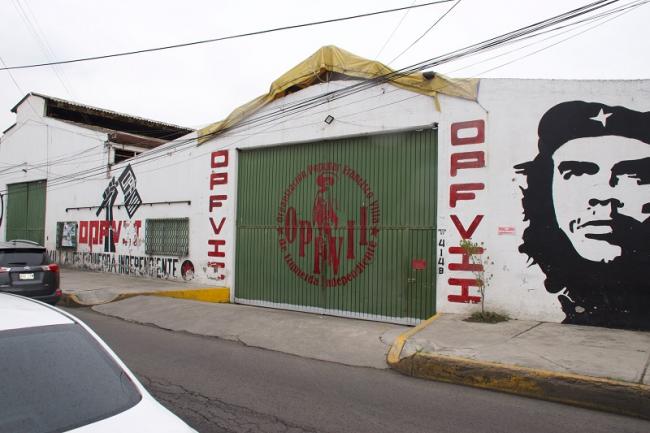
Para leer este artículo en español, haz clic aquí.
On the evening of May 3, Carlos Zoe was returning home from a long shift at a call center in Mexico City. Arriving at Metro Zapata, Carlos ran to catch the Linea 12, which would take him to Metro Olivos, just two blocks from his home in the city's peripheries. Carlos arrived at the platform moments too late, watching the train's doors close. It pulled out of the station without him.
As he impatiently waited for the next train, Carlos didn't know how lucky he was. Only half an hour later, at 10:22 P.M., just before his missed train arrived at Metro Olivos, a section of the elevated tracks collapsed, causing that same train to plummet 50 feet, killing 26 passengers and seriously injuring 80.
For members of Buena Suerte, an autonomous community located in an occupied factory blocks away from Metro Olivos and home to Carlos Zoe, this tragedy wasn't an accident. They view the collapse not as a mere structural failure of an overpass but rather as a consequence of the structural failures of capitalist development, urban inequality, and political corruption, which they have long struggled against. Founded in 2011, a year before the opening of the Linea 12, Buena Suerte is one of the eight communities of the Organización Popular Francisco Villa de Izquierda Independiente (Francisco Villa Left Independent Popular Organization, OPFVII), a radical leftist housing movement that has been active in the area since the 1980s. Emerging from the militant wing of Mexico City's Urban Popular Movement, the Panchos, as members call themselves, seek not just to secure housing for the urban poor but to build autonomous self-organized communities grounded in practices of collective decision making, mutual aid, and solidarity.
Since 2006, when the Linea 12 was first proposed, the Panchos have been vocal critics of the megaproject, questioning the forced dispossession of communal lands to build the Metro, the model of urban development the project implied, and the corruption of the politicians and developers involved. While grassroots opposition was unable to stop the construction of the Linea 12, the May 3 crash reinforces how this megaproject negatively impacts the poor and working people of the periphery. As Alejandro Gómez López, a construction worker who has lived in Buena Suerte since 2012, put it, "Unfortunately, those of us who have the least, those who work the hardest, those who struggle the most, are always the ones who pay for the shortcomings, bad decisions, and shoddy work of others."
The Night of the Crash
In Buena Suerte on the night of May 3, Carlos' mother, Elizabeth Torres, was preparing to go to sleep when suddenly the community's electricity, pirated from a nearby powerline, went out. Over the next few minutes, as the sounds of sirens and helicopters grew, it became clear that a disaster was unfolding just outside their community. Elizabeth soon learned the precise nature of the disaster when her son called her to let her know that he would be late.
Carlos had been ordered off his train one station before Metro Olivos and had to traverse the chaotic scene on Tláhuac Avenue to return home. Over the phone, Elizabeth heard the tragedy unfolding, "It was really horrible when he called me because I could hear how people were shouting and crying for help. The wailing was so sad, so desperate, and I felt so helpless." Carlos walked past a makeshift triage center on the sidewalk outside a McDonald's, already filled with injured people pulled from the rubble. He took side streets to bypass the police cordon to prevent the efforts by the growing crowd to pull victims from the wreckage.
As news of the disaster spread inside Buena Suerte, people flowed out of their small houses, constructed out of cinderblock and tin-roofing, into common areas. Rumors about the military attacking the crowds and people getting robbed at gunpoint amidst the confusion spread, and the community sprang into action. Collectively, they decided that no one would leave the community. A count was conducted, household by household, to ensure no one was on the train that crashed. For the next hour, people called loved ones and milled about anxiously as they waited for the rest of the community to return home. While everyone feared the worst, within an hour, it became clear that thankfully no one from Buena Suerte had been on the train.
Viridiana Pastrana, an 18-year-old high school student, found out on social media the next day that one of her school friends, Eduardo, was seriously injured and receiving treatment in a nearby hospital. "It has been really traumatic because these are things that you never thought would happen, and then they happen when you are least expecting it," she said.
For the residents of Buena Suerte, the traumatic events of May 3 were just the beginning of their ordeal. They still had to show up to work the following day, even without the Metro.

Those Who Pay the Price
The residents of Buena Suerte are no strangers to hardship, coming from the humblest sections of Mexico City's working-class and scraping by working as informal street vendors, domestic laborers, call center employees, security guards, construction workers, and other precarious and low paying jobs. In this respect, the community is representative of Tláhuac, which is Mexico City's third poorest borough, with 39 percent of its population, or more than 150,000 people, living in poverty according to government statistics. Like Carlos, most of the community have jobs in the city center and, until May 3, were among the 200,000 daily passengers who relied on Linea 12 to take them to work, a journey that often meant spending two or more hours a day in public transit.
"The metro was really important," says Alejandro Gómez López. "It was how, as working-class people, we got to our jobs. Now, without the Metro, our commutes have become very difficult." A journey that took one hour now takes two or more, meaning that many in Buena Suerte find themselves suddenly spending four or more hours a day commuting. The impacts on daily life are numerous, affecting the time people spend with loved ones, participate in community activities, and rest. As Alejandro put it, "You wake up earlier to go to work, and you get back home to sleep later."
While classes have been remote, Viridiana has seen the effects of this added commute on her parents. Her father, who works 24-hour shifts as a security guard, now wakes up at 5 A.M. to get to work and doesn't arrive home until 10 A.M. the next day. Her mother, a housekeeper employed by a family near the Ángel de la Independencia in the city center, was told she would be fired if she continued to arrive late. For Viridiana, this is emblematic of the inequality in Mexico. "My mom's boss doesn't stop and think about what we are going through,” she says. “The politicians who got rich stealing money from the construction of the Metro today drive the latest model cars and don't care about public transport."
Beyond the longer commute, the cost of alternative routes is often twice as much as what people were paying before. "It's totally excessive," Carlos said, explaining how the new cost of transport cuts into what he takes home at the end of the day. On May 27th, responding to criticisms about cost, the city established a free metro bus route that stops at the most popular stops on the Linea 12. While this free transport is a relief for residents of Buena Suerte, it entails a long walk to the stations of Nopalera or Tezonco.

Resisting Structures of Urban Inequality
By facilitating the movement of the urban poor from the southeastern periphery to the center of Mexico City, Linea 12 is an infrastructural solution to one of the spatial puzzles of urban inequality. The construction of the train maintains a socio-spatial division that consigns the urban poor to the peripheries of the city while still allowing wealthier parts of the city to benefit from their labor.
As Gerardo Meza, a member of the OPFVII's political coordination, put it, "Linea 12 is part of an urban strategy of capitalist development to connect the periphery with the urban center, and through the expropriation and dispossession of land, turn these communities into cuidades dormitorios, commuter towns."
When former Mexico City mayor Marcelo Ebrard first proposed Linea 12 in 2006, it was clear that construction would entail the expropriation of communal lands still being farmed in the urban periphery. Campesinos, whose communal ejido lands were being expropriated for the construction of the Metro, formed an organization called Frente de Pueblos de Anáhuac (Anáhuac People’s Front, FPA) to defend their territory against the megaproject. The Panchos joined in solidarity, attending protests and marches against the construction of the Metro.
This movement faced severe repression from the city government. In September 2009, Marcelo Ebrard sent 5,000 riot police to arrest and evict members of the FPA, an act of state repression that ultimately succeeded in demobilizing the grassroots opposition to the Metro. In response to this act of state repression, organizations in solidarity with the FPA, including the OPFVII, blockaded the main avenue in Tláhuac and released a collective later in which they argued that "The Linea 12 of the Metro doesn't necessarily signify development or progress. Instead, it is part of an ambitious plan of urbanization in the southeast of the city, from which politicians and developers hope to obtain benefits."
For the OPFVII, this repression did not come as a surprise. Indeed, as Gerardo Meza explained, Marcelo Ebrard, 15 years earlier, was the architect of a counterinsurgency strategy meant to divide and demobilize the Panchos. According to Meza, throughout the 1990s, this plan led to relentless persecution of the Panchos, including the arrests of prominent leaders. This strategy ultimately culminated in a factious split in the movement where a large section abandoned autonomous forms of organizing to join Marcelo Ebrard's newly formed political party, the PRD.
This criticism of the proposed megaproject's corruption proved accurate as construction began. Carried out by three large construction companies, including CARSO, a construction firm owned by Carlos Slim, the wealthiest man in Mexico, the construction was, as Gerardo described it, "plagued by a series of irregularities and corruption: the use of low-quality materials, jobs that were never completed, engineering studies of the soil that were paid for but never carried out."
In 2014, just over a year after the Metro was opened, it had to be closed for six months when it was discovered that the trains that had been purchased did not meet the proper safety specifications and were causing structural damage to the tracks. As a governmental panel was convened to investigate allegations of corruption, Marcelo Ebrard fled to France, where he remained until he joined Andrés Manuel López Obrador’s campaign for president in 2018. He is now the Secretary of Foreign Affairs under AMLO.

Justice Beyond the Elections
While the Panchos have been critics of Linea 12 long before the tragic events of May 3, in the weeks following the crash, politicians and political parties sought to capitalize on the tragedy to win votes in Mexico's upcoming midterm elections. Today, Marcelo Ebrard is widely seen as a possible successor to Mexico's current president. Opposition political parties saw the collapse as a means of tarnishing the image of MORENA, which currently controls the presidency and holds a majority in both houses of the Mexican Congress. MORENA, in turn, sought to defend Ebrard by blaming the previous administration of Miguel Ángel Mancera of the opposition party, the PRD. In the June 6 mid-term elections, the Metro collapse was cited as a possible contributor to MORENA losing key races in Mexico City.
For Gerardo, these promises of justice for the victims of the tragedy at the ballot box are cynical maneuvers. Emphasizing that Ebrard himself has belonged to three parties in power over the past three decades—the PRI, the PRD, and now MORENA—Gerardo cautions that "whatever party is in power, it's the same thieves."
Despite the popular discourse of the current administration that claims to be on the side of working people, to David Contreras, a longtime member of the OPFVII, "the government continues to operate according to a neoliberal logic, one based on repression and dispossession."
For the Panchos, justice in the urban peripheries cannot come from the ballot box or the very government that has long upheld the forms of inequality that shape the lives of the urban poor. Instead, justice will come from the deepening of the communal ties and forms of collective decision-making already taking shape in communities like Buena Suerte, allowing the urban poor, and not politicians or developers, to shape the future of the territories in which they live.
Sam Law, a PhD candidate in the Department of Anthropology at the University of Texas at Austin, writes about urban autonomy, communal responses to precarity, and the emancipatory horizons of contemporary political struggle in Mexico. He currently lives in Mexico City.

